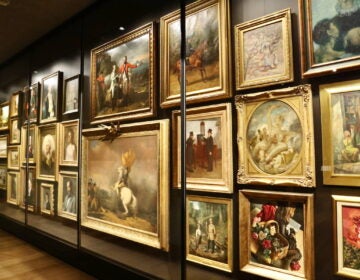Imagining Africa—with the help of museum visitors
The Africa room at the University of Pennsylvania Museum of Anthropology and Archeology is sorely in need of an overhaul. The museum is seizing the revamping of its Africa room as a teachable moment for the public—and itself.
“What first comes to mind, when you hear ‘Africa’?”
Kate Quinn, the director of exhibitions at the University of Pennsylvania Museum of Anthropology and Archeology, has been asking that question at the museum, in public meetings, and in outreach forums.
“Most people were telling us zebras and giraffes and safari. Some said drumming. A lot of people said the Toto song ‘Africa,’ which is completely off base,” said Quinn.
The Africa room at the Penn Museum was last upgraded more than 25 years ago; it’s sorely in need of an overhaul. The room is poorly lit, objects are set behind glass in dark wood cases, and the point of the arrangement is unclear.
“It’s not a unified vision,” said Quinn. “It’s been put together haphazardly through the years.”
The museum is seizing the revamping of its Africa room as a teachable moment for the public—and itself.
“We’re really taking that and embracing what people know about Africa,” said Quinn. “A lot of what you have to do when teaching people is un-teach them. When they come in, you have to take away what they know and start over.”
An inclusive approach
The museum is taking a novel approach by setting up an African exhibit designed to solicit feedback from visitors about how to exhibit Africa. The hallway outside the Africa room is a temporary arrangement of computerized interactive displays, dry-erase boards begging for answers to provocative questions (“What makes a nation powerful?”), pop culture candy, and tribal objects from the collection.
Called “Imagine Africa,” it will remain set up for about a year collecting reactions from visitors. Those responses will help curate the future Africa room.
In the hallway outside the room, video screens flicker with visions from the collective imagination: Liz Taylor from “Cleopatra”; Forest Whitaker from “The Last King of Scotland”; and “The Lion King.”
There are also images of industrial centers and dense urban areas. One of the challenges the museum faces is how to present a more complete vision of Africa with mostly tribal objects.
“Most of our collection is based in colonial Africa, and most of our collection was collected with the intention of displaying them as art objects,” said Quinn of the museum’s 20,000 pieces. “But there are other stories we can tell you about these things.”
Expanding its reach
As the museum reaches out to African and African-American community groups–and partners with schools on education programs—Quinn says it might acquire newer, more cosmopolitan African objects.
Stanley Straughter, also the chairman of the Mayor’s Commission on African and Caribbean Affairs, is a member of the museum’s advisory committee. He admits that the main reason he goes to 32nd and Spruce streets–the location of the museum –is to see the Penn Relays across the street at Franklin Field.
“It’s a world-class institution in our community,” said Straughter. “In my experience, it has not reached out to the black community as it should have, especially with such a prominent collection.”
WHYY is your source for fact-based, in-depth journalism and information. As a nonprofit organization, we rely on financial support from readers like you. Please give today.




